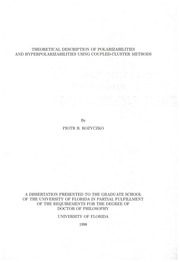Table Of ContentTHEORETICAL DESCRIPTION OF POLARIZABILITIES
AND HYPERPOLARIZABILITIES USING COUPLED-CLUSTER METHODS
By
PIOTR ROZYCZKO
B.
A DISSERTATION PRESENTED TO THE GRADUATE SGHOOL
OF THE UNIVERSITY OF FLORIDA IN PARTIAL FULFILLMENT
OF THE REQUIREMENTS FOR THE DEGREE OF
DOCTOR OF PHILOSOPHY
UNIVERSITY OF FLORIDA
1998
To my wife Ewa and our daughter Ola.
ACKNOWLEDGMENTS
I would like to thank Dr. Rodney J. Bartlett, whose dedication and persistency
to teach quantum theory are limitless. His patience and open-mindedness have
made the time I have spent working for him very enjoyable and interesting.
••
Thanks go to Dr. Yngve Ohrn for his excellent lectures on the subject of
polarizator propagator, which were a very strong influence on the focus of my
studies.
I would also like to express my acknowledgements to Dr. Henk Monkhorst,
who was always very helpful to me and never left my questions unanswered.
Thanks go to Dr. Mike Zerner for assuring me that writing a thesis is not as
hard or as scary as I thought.
I would like to thank Dr. Jim Deyrup, who helped me enormously right after
my arrival to this University and throughout my entire studies.
Ill
TABLE OF CONTENTS
page
ACKNOWLEDGMENTS
iii
LIST OF TABLES vi
LIST OF FIGURES viii
ABSTRAGT
ix
GHAPTERS
INTRODUGTION
1 1
2 MOLEGULAR STATIC AND DYNAMIC PROPERTIES 4
2.1 Introduction 4
2.1.1 First Hyperpolarizability, (5 7
2.1.2 Second Hyperpolarizability, 7 10
2.2 Description Using Hartree-Fock Methods 11
2.3 Description Using Correlated Methods 13
2.3.1 Many-Body Perturbation Theory Based Methods 13
. .
2 3.2 Linear and Quadratic Response Methods 15
.
COMPUTATIONAL METHODS USING COUPLED-GLUSTER
3
WAVEFUNGTION
17
3.1 Rayleigh-Schrodinger Perturbation Theory Based Methods 17
3.1.1 Time-Dependent Derivation of the First Polarizabil-
ity Expressions 23
3 1.2 Role ofthe Renormalization Terms in the Sum-Over-
.
States Expression 34
3.2 Brillouin-Wigner Perturbation Theory Based Methods ... 39
4 APPLIGATIONS TO MOLECULAR SYSTEMS 47
4.1 First Polarizability and Long-Range Dispersion Coefficients 47
4.2 First and Second Hyperpolarizability 67
4.2.1 Hydrogen Fluoride 67
4.2.2 trans-Butadiene 77
CONCLUSIONS AND FUTURE WORK
5 91
IV
APPENDIX CANCELLATION OE THE DISCONNECTED TERMS
A:
IN THE BW-CCSD METHOD 94
APPENDIX COMPUTATIONAL IMPLEMENTATION
B: 95
APPENDIX C: NAMES, ABBREVIATIONS AND UNITS 97
REFERENCES
99
BIOGRAPHICAL SKETCH
106
V
LIST OF TABLES
Table page
3.1 Role of the renormalization terms at equilibrium geometries 37
EOM-CCSD
3.2 Percentage error of the static hyperpolarizabilities for
(LiH)„ 38
3.3 Resonant linear polarizabilities of the HE molecule 46
4.1 Dipole moments of the HE molecule 51
4.2 Ofzz component of the static polarizability for the HE molecule. ... 51
4.3 Dynamic polarizabilities of the N2 molecule" 55
4.4 Dynamic polarizabilities of the CO molecule" 56
4.5 Dynamic polarizabilities of the C2H2 molecule" 57
4.6 Dynamic polarizabilities of the CI2 molecule" 58
4.7 Dynamic polarizabilities of the CO2 molecule" 59
4.8 Dynamic polarizabilities of the OCS molecule" 60
4.9 Dynamic polarizabilities of the CS2 molecule" 61
4.10 Dynamic polarizabilities of the C4H6 molecule" 65
4.11 Ce dispersion coefficients for homonuclear interaction 67
4.12 EOM-CCSD unnormalized static and dynamic (iv = 0.0656 a.u. /
694.3 nm) hyperpolarizabilities of the HE molecule (in a.u.) at
RffP=1.7328 a.u., except where indicated 72
4.13 CCSD and CCSD(T) orbital relaxation and basis set effects (in
( )
HE
a.u.) in the j3 and 7 static hyperpolarizabilities of 75
4.14 Geometry of the trans-butadiene molecule at various levels of opti-
mization 80
4.15 Static and dynamic hyperpolarizabilities of trans-butadiene (in 10^
a.u.) in geometry 1 81
VI
4.16 Static and dynamic hyperpolarizabilities of ^rans-butadiene (in 10^
a.u.) in geometry II 82
4.17 Second hyperpolarizabilities of trans-butadiene at the experimental
geometry (III) 83
4.18 Adjusted values ofdynamic hyperpolarizabilities (dc-SHG) for trans-
butadiene in the POLH--I- basis 86
4.19 Excitation energies of trans-butadiene at the experimental geometry 87
1 Names and abbreviations for various linear and nonlinear processes . 98
2 Units and Equivalences 98
Vll
LIST OF FIGURES
Figure page
4.1 Mean dynamic polarizability of CO2 in the POLl basis set 62
4.2 Mean dynamic polarizability of CS2 in the POLl basis set 63
4.3 Average dynamic hyperpolarizability of trans-butadiene in the 6-
31G-f(P,D) basis set 89
4.4 Average dynamic hyperpolarizabilityoftrans-butadiene in the POLl
basis set 89
4.5 Average dynamic hyperpolarizabilityof trans-butadiene in the POLl-t-4-
basis set 90
Vlll
Abstract of Dissertation Presented to the Graduate School
of the University of Florida in Partial Fulfillment of the
Requirements for the Degree of Doctor of Philosophy
THEORETICAL DESCRIPTION OF POLARIZABILITIES
AND HYPERPOLARIZABILITIES USING COUPLED-CLUSTER METHODS
By
Piotr B. Rozyczko
December 1998
Chairman: Dr. Rodney J. Bartlett
Major Department: Chemistry
This thesis is devoted to the development and application of new theoretical
methods based on the coupled cluster formalism designed for better and more
general description of linear and nonlinear electro-optic effects in molecules.
Starting with the general perturbation theory we derive equations for linear
polarizability and first- and second-order hyperpolarizability. We present both the
derivation and numerical results for the analytic Equation ofMotion Coupled Clus-
ter (EOM-CC) method, the BW-EOM-CC (Brillouin-Wigner EOM-CC) method
and the less attractive but more numerically complete energy derivative formula.
We describe in detail the advantages and disadvantages of including the renor-
malization terms in the Sum Over States (SOS) expression, widely used for this
type of calculations, show ways to eliminate some of these terms and discuss their
numerical importance.
IX
Our most powerful method BW-EOM-CC based on the Brillouin-Wigner per-
turbation expansion is attractive for many reasons. It not only is fully size-
extensive but also permits calculations ofthe properties at the frequency ofelectron
resonance, where all other methods based on the Rayleigh-Schrodinger perturba-
tion theory fail.
We
report the numerical results for several interesting systems, including the
trans-butadiene. Theoretical prediction of nonlinear properties of this molecule
has become a true test of quality and accuracy of any new method.
X

